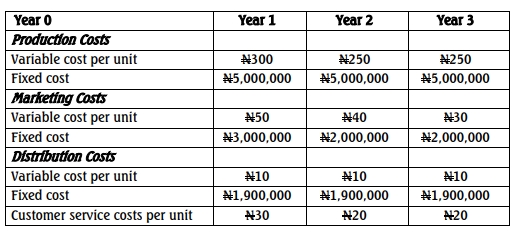Bascon Foods Plc is a producer of fast-moving consumer goods in Nigeria. Since it commenced business in 1960, the company has been providing Nigerians with high-quality food products, such as cereals, cocoa beverages, confectioneries, and soaps, all at competitive prices. The following product brands consistently command 10% of the market share in their segments: Bascon Cornflakes, Bascovite Chocolate Beverage, Rave Cream Soap, and Bascon Digestive Biscuits, which have all become household names among Nigerian consumers.
In 2021, the company launched Rave Ice Cream as part of its growth strategy through diversification in response to the increasing demand for ice cream. Unfortunately, a year after its launch, sales have been very low, with Bascon Foods Plc struggling to break even on this product line. The ice cream market is reportedly growing at a rate of 5%, but the market share for Rave Ice Cream is under 0.5%.
Additionally, Bascon Cornflakes, the company’s flagship product, saw a significant annual sales decline of 5% from 2019 to 2021. This decline is partly due to intense competition, with a major global brand, Nekloggs, entering the Nigerian market. The current market share for Bascon Cornflakes is 2% in a market growing at 16%. Conversely, Bascovite Chocolate Beverage has consistently experienced a 6% annual sales growth from 2016 to 2021. The chocolate beverage market is reportedly growing at an annual rate of 8%. Market shares for Rave Cream Soap and Bascon Digestive Biscuits have remained steady over the past seven years at 5%, with a 7% growth rate in both markets. Profits from Bascovite Chocolate Beverage, Bascon Digestive Biscuits, and Rave Cream Soap have been stable and high. Despite the challenges, all brands, except Rave Ice Cream, maintain dominant positions in their respective markets, all of which are fast-growing.
The Board of Directors of Bascon Foods Plc is considering outsourcing non-core activities as a cost-saving strategy across all product lines. The proposed outsourcing strategy is expected to reduce costs and help Bascon become a low-cost producer of household food items.
Required:
As a consultant to Bascon Foods Plc, advise the company’s management on:
a. The position of each of Bascon Food Plc’s products in the product lifecycle.
(10 Marks)
b. The appropriate strategy for each of Bascon Foods Plc’s product brands, using the life-cycle portfolio matrix.
(5 Marks)
c. The classification of each product within the Boston Consulting Group (BCG) model.
(10 Marks)
d. Suggested strategies for each classification identified in part (c).
(5 Marks)



